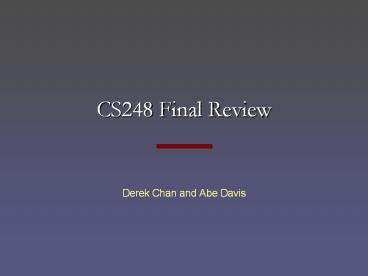CS248 Final Review - PowerPoint PPT Presentation
Title: CS248 Final Review
1
CS248 Final Review
- Derek Chan and Abe Davis
2
CS248 Final
- Monday, December 8, 330 to 630 pm
- Closed book, closed notes
- Mainly from material in the second half of the
quarter - Project submission and writeups along with
partner evaluations due today
3
CS248 Final Review Contents
- Topics from second half of the course
- Image warping, texture mapping
- Perspective
- Visibility
- Lighting / Shading
4
(No Transcript)
5
(No Transcript)
6
Textures
- Mipmapping
- multi-resolution texture
- bilinear interpolation at 2 closest resolutions
to get 2 color values - linear interpolate 2 color values based on actual
resolution - Summed area tables
- fast calculation of prefilter integral in texture
space
7
Viewing Planar Projections
- Perspective Projection
- rays pass through center of projection
- parallel lines intersect at vanishing points
- Parallel Projection
- center of projection is at infinity
- oblique
- orthographic
8
Specifying Perspective Views
- Observer position (eye, center of projection)?
- Viewing direction (normal to picture plane)?
- Clipping planes (near, far, top, bottom, left,
right)?
9
Viewing OpenGL Pipeline
- Object Space
- Eye Coordinates
- Projection Matrix
- Clipped to Frustum
- Homogenize to device coordinates
- Window coordinates
- Why is clipping before homogenization?
10
Visibility
- 6 visible-surface determination algorithms
- Z-buffer
- Watkins
- Warnock
- Weiler-Atherton
- BSP Tree
- Ray Tracing
11
Things to know
- how does it work
- what are the necessary preconditions?
- asymptotic time complexity
- well-suited for hardware?
- how can anti-aliasing be done?
- how can shading be incorporated?
- parallelizable?
- ease of implementation
- best-case/worst-case scenarios
12
Z-buffer
- Project all polygons to the image plane, at each
pixel, pick the color corresponding to closest
polygon
13
Watkins
- Scanline depth
- progressing across scanline, if pixel is inside
two or more polygons, use depth to pick - process interpenetrating polygons
14
Warnock Subdivision
- Start with area as original image
- subdivide areas until either
- all surfaces are outside the area
- only one inside, overlapping or surrounding
- a surrounding surface obscures all other surfaces
15
Weiler-Atherton Subdivision
- Cookie-cutter algorithm clips polygons against
polygons - front to back sort of list
- clip with front polygon
16
BSP Trees/List Priority
- Provides a data structure for back-to-front or
front-to-back traversal - split polygons according to specified planes
- create a tree where edges are front/back, leaves
are polygons
17
Ray Tracing
- Ray Casting
- for each pixel, cast a ray into the scene, and
use the color of the closest polygon - Parametric form of a line u(t) a(b-a)t
- Implicit form of the object
a
t
y
b
(0,0)?
x
18
Lighting
- Photometry vs Radiometry
- What's the difference?
19
Lighting
- Terminology
- Radiant flux energy/time (joules/sec watts)?
- Irradiance amount of incident radiant flux /
area (how much light energy hitting a unit area,
per unit time)? - Radiant intensity (of point source) radiant flux
over solid angle - Radiance radiant intensity over a unit area
20
(No Transcript)
21
Lighting
- BRDF Bidirectional Reflectance Distribution
Function - Description of how the surface interacts with
incident light and emits reflected light - Isotropic
- Independent of absolute incident and reflected
angles - Anisotropic
- Absolute angles matter
- Generalizations to the BRDF!
- Spatially/spectrally varying, florescence,
phosphorescence, etc.
22
Lighting
- Phong specular model
- Isnt true to the physics, but works pretty well
- Reflected light is greatest near the reflection
angle of the incident light, and falls off with a
cosine power - Lspec Ks x cosn(a), a angle between viewer
and reflected ray
N
L
R
V
23
Shading
- Gouraud shading
- Compute lighting information (ie colors) at
polygon vertices, interpolate those colors - Problems?
- Misses highlights
- need high resolution mesh to catch highlights
24
Shading
- Phong shading
- Compute lighting normals at all points on the
polygon via interpolation, and do the lighting
computation on the interpolated normals (of the
polygon)?
N2
N1
Implicit surface
Polygon approximation
25
Good Luck!
Good Luck on the Final! ?

